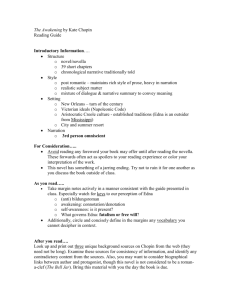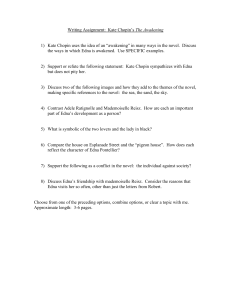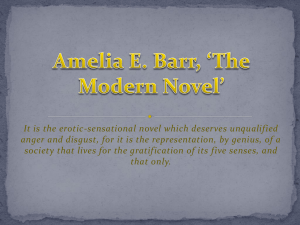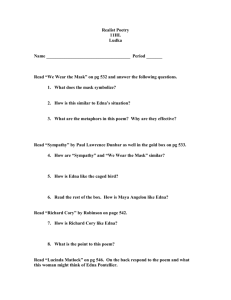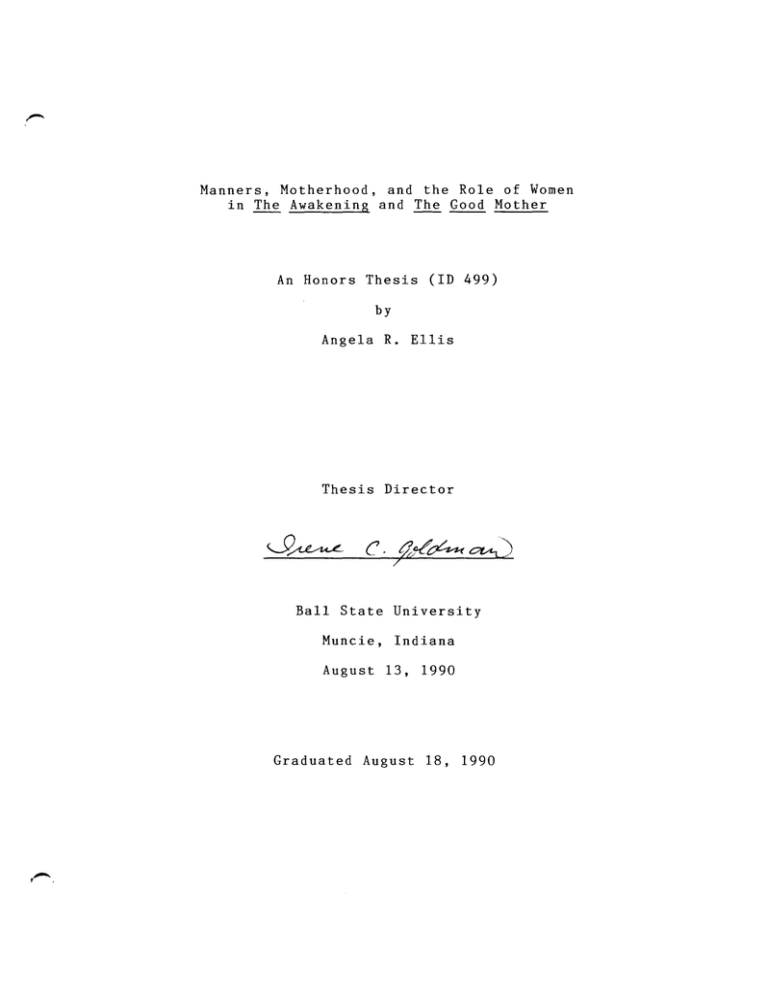
Manners, Motherhood, and the Role of Women
in The Awakening and The Good Mother
An Honors Thesis (ID 499)
by
Angela R. Ellis
Thesis Director
Ball State University
Muncie, Indiana
August 13, 1990
Graduated August 18, 1990
~.
t'
"' ··ft
'=t"-t'
1,
111e00
l.L,
''ius:'q
(~
II.......'
l
-Manners, Motherhood, and the Role of Women
in The Awakening and The Good Mother
Throughout our lives, most of us learn some type of manners-certain expectations about our behavior in various situations.
Manners may be as simple and clearly stated as those many of us
were taught as children; keep your elbows off the table; say
thank you; excuse yourself.
However, when we look closer at the
kinds of manners that affect our daily lives, we become aware of
a pervasive influence that is less easily defined.
For instance,
why is it customary to dress male babies in blue, but not in pink?
Why are household chores such as cooking and cleaning often
thought of as "woman's work"?
These behaviors result from societal
expectations that, although perhaps not explicitly stated, are
generally implied, and affect our lives in very personal ways.
How we perceive our roles as men or women, our attitudes toward
money and success, and the decisions we make about raising our
children are all aspects of our lives that are influenced by social
conventions.
The set of manners, or social conventions, varies
from one group to another, depending on factors such as age and
socioeconomic status.
This variation leads to conflict when an
individual misunderstands or disregards the accepted social standards of behavior.
The importance of manners to the novel lies in how they
-
affect the individual character.
When the connection between
2
manners and character is strong enough to warrant further study
of the relationship, then the work is considered a novel of
manners (Tuttleton 10).
It is not necessary that manners
themselves be the central focus of the novel; in fact,
often not the case.
this is
The Jane Austen novel, Pride and Prejudice
is about marriage, but the conflicts in the story arise out of
descrepancies in, and misunderstandings of manners.
James
Tuttleton, in The Novel of Manners in America, defines the novel
of manners:
By a novel of manners I mean a novel in which the
manners, social customs, folkways, conventions,
traditions, and mores of a given social group at
a given time and place play a dominant role in the
lives of fictional characters, exert control over
their behavior and thought, and constitute a determinant upon the actions in which they are engaged,
and in which these manners and customs are detailed
realistically--with, in fact, a premium upon the
exactness of their representation.
(10)
Tuttleton maintains that the novel of manners is "sociologically
oriented," and follows up this idea with a system of analyzing
society through five "areas of social experience" (11).
The
first and broadest category involves a "set of social conventions
and taboos regarding relations between the sexes, between parents
3
and children, as well as people's behavior in the company of
their fellowmen."
The second category deals with accepted
ethical standards, and the third looks at religious and philosophical beliefs on one's role in the universe.
Group four is
concerned with economic organization and the importance of
material wealth, and the last category examines the political
structure of the community (Tuttleton 11-12).
All five cate-
gories mayor may not affect a single novel of manners, but
breaking down the social experience into five aspects helps to
identify manners more specifically.
As it exposes the manners of a society in a specific
setting, the novel of manners provides a type of social history
that exemplifies the values of the time and place.
step further,
Taken one
this aspect of the novel of manners--with its
emphasis on realistic detail--allows for a comparative look at
the development of manners surrounding certain issues over a
period of time.
Two novels, separated by nearly a century,
illustrate this point: The Awakening, written by Kate Chopin
in 1899, and The Good Mother by Sue Miller in 1986.
In both
novels, social values concerning a woman's expected role in
society as it relates to the issues of motherhood, sexuality,
and independence are brought out by a woman's awakening to her
own potential.
The impact of manners becomes starkly apparent
as we see the consequences for two women who move beyond the
accepted social conventions.
Even more interesting are the
4
similarities of manners surrounding the role of women in each
novel, despite almost one-hundred years of change.
The ti.tles--The Awakening and The Good Mother--each have
significance in both novels.
The main character in each novel
is a woman who experiences an awakening that forces her to
question society's definition of her role as a woman.
woman redefines her own life,
conventions.
As each
she also disregards many social
This questioning and the consequent denial of societal
expectations creates the conflict between manners and the individual
that is necessary to the novel of manners.
In The Awakening
and The Good Mother, the central characters' expected roles as
women are directly tied to the fact that they are mothers.
Ultimately, their need for independence and their growing sexuality lead to a conflict between their needs as women and their
roles as mothers.
Edna Pontellier, the main character of Kate Chopin's
novel The Awakening, is twenty-eight years old and seems comfortably married with two children living in New Orleans.
Her
husband is a Creole, meaning Roman Catholic, and when the novel
opens, Edna and her family are spending the summer by the sea
at Grand fsle "in the society of Creoles" (Chopin 12).
The
Creole society itself implies a set of manners with which Edna,
who comes from "sound old Presbyterian Kentucky stock,"
completely at ease (87).
is not
She is constantly surprised by "their
5
entire absence of prudery" and "their freedom of expression"
(12).
Earlier in the summer, Edna was shocked to hear her friend Madame
Ratignolle tell one of the men all the details of her most recent
childbirth.
Manners concerning the relationship between the sexes
seem contradictory in several instances.
A Creole woman upholds
a "lofty chastity," yet it is perfectly acceptable for a young
single man named Robert to devote himself to Edna for the summer.
On the surface, this devotion is harmless because it is supposed to
be understood that this flirtation is not to be taken seriously;
therefore, "the Creole husband is never jealous" (14).
Madame
Ratignolle makes this assumption clear in her conversation with
Robert: "If your attentions to any married women here were ever
offered with any intention of being convincing, you would not be
the gentleman we all know you to be ••• " (26).
The reputation of
a lady and a gentleman rest on this understanding; however, the
preservation of manners on the surface does not protect underlying emotions.
This situation proves to be a precarious one
for a young woman unaccustomed to the "rules" and who is becoming
dissatisfied within the confines of her marriage.
Almost one-hundred years later, Anna Dunlap, the main
character in-Sue Miller's novel, The Good Mother, has also
realized that she is not happily married.
Like Edna Pontellier,
Anna is nearly thirty years old and -a mother.
Unlike Edna,
Anna lives in Massachusettes during a time when divorce is common;
6
-.
As the novel begins,
this option was not available to Edna.
Anna's divorce in almost settled.
She sees the divorce as a
way to free herself from ties to her family as well as her
husband.
All of her life, Anna has functioned within a set
of manners established by her mother's family.
Whereas Edna
was shocked by the Creole's "lack of prudery,"
Anna's family
was very closed on the subject of sexuality.
As a child she
was surrounded by love, "but love conditional on so much: on
being good: on doing well: on making the family proud" (97).
One of the early "demands" as she referred to her family's
expectations, included Anna's success as a pianist.
When she
realized that she "just wasn't that good," it was as if she had
failed to meet her family's expectations, and she began to pull
away from them (187).
"As a group, my mother's family held a
kind of invisible standard up to all its members' lives and
ambitions.
All the family bonds translated, finally,
appraisal, a push for achievement" (55).
into
Anna's marriage to
Brian provided some relief from her family's demands, and with
the divorce--another disappointment to her family--she felt she
had finally escaped them.
The idea of an escape from a restrictive set of manners
is important to both novels as a step toward fulfillment of
the emotional need for independence.
Anna's awakening began
with the idea of a divorce, and grew while the necessary details
7
were worked out.
society.
Piece by piece, Anna redefined her role in
She was now a divorcee, living in her own apartment,
with custody of her daughter Molly.
More importantly, with the
exception of a minimal divorce settlement to care for her child,
Anna had achieved financial independence.
As a piano teacher
with a flexible university laboratory job, she is able to support
herself.
easy.
For Anna, this excape to independence is comparatively
She can legally divorce her husband without scandal, and she
has the means to provide for herself.
In Edna's situation the
achievement of independence is more difficult for several reasons.:
First of all,
because of the wealth and status of Edna's husband, -
she has many social obligations to which Anna is not subjected.
Secondly, Edna must also consider her children
means of financial support.
husband.
and have some
Finally, she cannot divorce her
Edna overcomes each of these obstacles, and her pointed
disregard for established manners concerns those people who are
close to her.
Upon her return to the city at the end of the summer at Grand
Isle, Edna begins to consciously ignore many of her social and
household obligations.
Much to the chagrin of her husband,
Edna chooses-lto be out on a Tuesday, her usual reception day,
without a good excuse.
Mr. Pontellier tells Edna that by now
she should understand "That people don't do such things; we've
got to observe les convenances if we ever expect to get on and
8
keep up with the procession" (67).
"Keeping up with the procession"
is no longer of any importance to Edna, who responds by completely
giving up her receiving days, as well as the running of the household.
Edna's husband is aware of society's expectations of a
woman, especially one of their own social circle, and he is shocked
by her "absolute disregard for her duties as a wife .•. " (75).
of this disregard for her "duties"
more time at her painting.
Part
is the result of Edna spending
According to her husband, it is "the
utmost folly for a woman at the head of a household, and the
mother of children, to spend in an atelier days which would be
better employed contriving for the comfort of her family" (75).
Mr. Pontellier presents an ~raLe summary of Edna's expected
role as a woman.
Edna's move toward independence seems nearly
complete when her children are removed to their grandmother for
several weeks.
She has already given up any obligation she felt
to her husband, who is conveniently away from home on business.
All that remains is for her to move out of their large house
and into a smaller one of her own, taking only those household
articles that actually belong to her.
Edna's goal is financial
independence, made possible by a small income of her own, enhanced by the sale of some of her paintings.
Always conscious
of appearances, Mr. Pontellier explains this awkward social
situation by arranging for the remodeling of his home, which
-
would necessitate the absence of the family.
9
At this point, Anna and Edna have both achieved a high
degree of independence.
But because they are mothers they
are subject to society's restrictions in ways they might not
•
be if they did not have children.
•
To Anna, her daughter
Molly is the most significant part of her life, and as a mother,
Anna is willing to give anything of herself for her child.
Anna's
new independence requires her to work about forty hours per week,
during which time Molly goes to a daycare center.
It is typical
for a father to spend this much time away from his child, and this
was always the case with Anna's ex-husband Brian.
However, there
seems to be a stigma attached to working mothers, and the
is that the child will suffer in her mother's absence.
~
assumpti~n
Anna's
grandfather represents this view, and also implies that she is se1findulgent in her need for independence, at the expense of her
daughter's happiness.
He tells Anna that "there is no reason why
[Molly] should suffer because of the decisions you've made about
your life" (119).
When Anna rejects her grandfather's offer of
financial assistance, she is also rejecting the societal views
that he represents, in favor of her own judgement about what is
best for her child.
Edna
an~nna
to their children.
differ greatly in their respective attachments
Edna is fond of her children, and has strong
bursts of affection for them, but she does not miss them when they
are away from her.
-
She visits them at their grandmother's home
10
in the country and "wept for very pleasure when she felt their
little arms clasping her," and left them "with a wrench and a
pang" (125).
"All along the journey homeward their presence
lingered with her like the memory of a delicious song.
But by
the time she had regained the city the song no longer echoed in
her soul" (126).
In short, Edna is not a "mother-woman."
Chopin
describes the mother-women as "women who idolized their children,
worshiped their husbands, and esteemed it a holy privilege to
efface themselves as individuals .•• " (10).
Edna does not idolize
her children or worship her husband by any means, but it is the
last part of the description that marks the real difference between
Edna and her friend Madame Ratignolle, who Chopin provides as a
model of society's ideal of the woman's role as a mother.
The
antithesis to the mother-woman is Mademoiselle Reisz, a pianist
who is completely devoted to her music.
She is considered odd
and disliked by many people, but she and Edna are friends.
Edna
compares herself to both of these roles, and admires both women,
but she can adopt neither of their lives for her own.
She has
not committed herself to her children or to her art, but only
to her own independence.
As a result, her husband criticized
her for neglecting her family,
just as in The Good Mother Anna,
who is admittedly committed to her child, was accused of causing
her child to "suffer" for her decisions.
-
In both novels, as Edna and Anna found the independence they
11
required, each woman also experienced an awakening to her own
sexuality.
amounts
her heart
In Edna's case, the physical aspect of this awakening
to a brief affair with a reputed "ladies' man," although
is
with Robert in Mexico.
experience on her family
is
The impact of Edna's sexual
minimal until the conclusion of the
novel, and even then the extent of her relationships may not have
been known to them.
Edna's friend, Madame Ratignolle, expressed
her concern for Edna's relationship with Arobin because his
"attentions alone are enough to ruin a woman's name" (127).
The
interest here is not in Edna's heart, but in her reputation, which
her blatant disregard for social propriety has endangered.
Madame
Ratignolle also advises Anna against living alone because the
world is "evil-minded."
When Robert returns from Mexico, Edna's
assertiveness leads them to confess their love for each other,
although somewhat reluctantly on his part.
He told Edna that he
has been fighting his love for her because she is not "free."
As far as he is concerned, she is Leonce Pontellier's wife.
In
Edna's mind she had already freed herself from any obligation to
her husband, and she tol d Rober t
that "I
all!
-no longer one of Mr.
Pontellier's possessions to dispose of or not.
where I choose" (143).
I give myself
After more words of love, Edna left to
attend a friend, with the promise from Robert that he would wait
for her.
She returned only to find a note saying "I love you.
Good-by--because I love you lf (148).
Edna thought she had escaped
12
society's restraints, but was forced to confront them in the form
of Robert, who was unable to free himself as she had done.
The effect of this experience on Edna's motherhood is
drastic, but questionable.
As she leaves Madame Ratignolle's
birth scene to return to Robert, her friend begged her to "think
of the children" (146).
She does think of them on her way home
and confesses that she needed her independence, but would not
want to "trample upon the little lives" in order to have her own
way (147).
Arobin,
She has realized after Robert left that "To-day it is
to-morrow it will be some one else.
It makes no differ-
ence to me, it doesn't matter about Leonce Pontellier--but Raoul
and Etienne!" (151).
The children seem to be a consideration of
-
responsibility for Edna, because she describes them as "antagonists
who had overcome her .•• and sought to drag her into the soul's
slavery for the rest of her days" (151).
Edna
is
willing to
give up the "unessential" for her children, but she could not
sacrifice herself.
She could go on having lovers but will not
subject her children to the scandal.
However, neither will she
give up her soul to be society's version of a dutiful wife and
mother.
Ultimately, the "unessential"
that Edna gives up is her life.
Anna Dunlap's sexual awakening almost one-hundred years
later is described much more explicitly.
As a divorced woman,
it is not unusual that she should have a lover, and Anna does so
openly.
of
Ann~
Society's concern in this relationship is the acceptability
as a
mothe~
having a lover.
However, Anna's independence
and her reliance on her own decisions concerning
Moll~
bring Leo
and Molly together in a relationship that to Anna is ideal.
Anna's
13
,passion for Leo leads them into a great deal of sexual freedom
around Molly.
In one critical instance, Molly's own curiosity
provokes an incident of sexual contact that in Anna's eyes may
have seemed innocent; however, Anna's ex-husband interprets it
as an example of sexual misconduct and begins a custody battle.
Had this incident occurred within a family setting and involved
Molly's father,
society may have been
understanding,
but manners
surrounding sexual conduct as it relates to children are explosive.
Suddenly Anna, like Edna,
is forced to confront the manners she
had tried so hard to escape.
Not only does she have to confront
-
society's expectations, she has to wage a battle for her daughter on the terms which she has rejected.
legal means to preserve manners.
Society can even resort to
Essentially, society is in a
position to judge who would be a better parent.
Brian has a wife
and a successful career; Anna is a piano teacher and has a live-in
lover without a "steady" job.
Brian and his wife are very conser-
vative regarding sexual issues and Molly; Anna feels it is better
to be open about sex.
Through the custody battle, society's
preference for certain characteristics of a good mother become
apparent.
Finally, Anna loses custody of Molly to her ex-husband.
The relationship between manners and morals is not the
same for every novel of manners.
In a Jane Austen novel, for
example, manners and morals have a positive correlation; if a
character has good manners, she is probably a good person.
-
In
the The Awakening and The Good Mother, the relationship is a little
14
more complex.
In both novels, manners are very important for
appearances, and a disregard for these manners can be fatal.
However, good manners do not necessarily indicate good moral
character, any more than a lack of attention to manners proves
a bad moral character.
In The Awakening, Mr. Pontellier is
extremely concerned about manners,
for his wife.
for Molly,
but expresses little concern
In The Good Mother, Leo had a strong affection
but when he went beyond the accepted boundaries of
behavior, his affection for her did not matter to society.
Gary Lindberg points out that typically the relationship between
in individual character and social convention turns out to be
"more serious, difficult, dense, and demanding that
characters had expected" (4).
Anna and Edna.
the central
This is exactly the case for both
Each character thought she was escaping the
constraints of social conventions as she moved toward her own
fulfillment as a human being and as a woman; however, unless one
chooses to live a solitary life, manners still affect us through
the people we care about.
As each woman disregards manners in
her life, she is forced to face the consequences of that action;
in these novels it meant death and the loss of a child.
Even with the intervention of nearly a century of social
change, manners surrounding the issues of independence and
sexuality as they effect women,
changed very little.
~
particularly mothers, have
Even if women such as Edna Pontellier and
Anna Dunlap are willing to move beyond accepted social standards
15
to fulfill their own potential, they seem to be unable to escape
the judgement of societal demands.
In The Awakening, an artist
friend of Edna's tells her that "The bird that would soar above
the level plain of tradition and prejudice must have strong wings.
It is a sad spectacle to see the weaklings bruised, exhausted,
fluttering back to earth" (110).
Edna and Anna, representative
of two different times, did soar beyond the plain of tradition;
but in the end they were brought down by commitments to people
and a society unable to soar with them.
16
Works Cited
Austen, Jane.
Pride and Prejudice.
1813 orig. date. London:
Oxford University Press, 1985.
Chopin, Kate.
The Awakening.
1899 orig. date. New York:
Bantam Books, 1981.
Lindberg, Gary.
Edith Wharton and the Novel
£i
Manners.
Charlottesville: University Press of Virginia, 1975.
Miller, Sue.
The Good Mother.
New York:
Dell Publishing Co.,
1986.
Tuttleton, James.
The Novel
£i
Manners in America.
University of North Caroling Press, 1972.
Chapel Hill:

